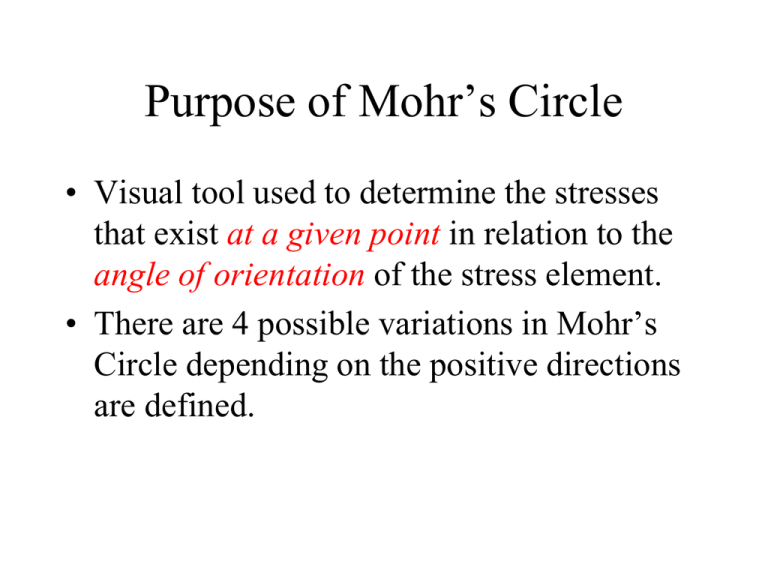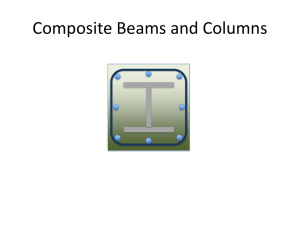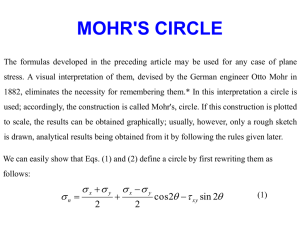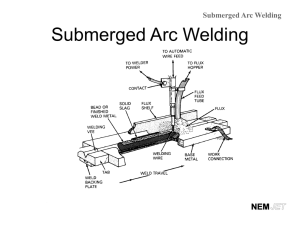More Mohr`s Circle
advertisement

Purpose of Mohr’s Circle • Visual tool used to determine the stresses that exist at a given point in relation to the angle of orientation of the stress element. • There are 4 possible variations in Mohr’s Circle depending on the positive directions are defined. Sample Problem y A particular point on the part x sy = -2 ksi Some Part sx = 6 ksi x & y orientation txy = 3 ksi Mohr’s Circle t (CW) sy = -2 ksi x-axis sx = 6 ksi (6 ksi, 3 ksi) 2 6 3 txy = 3 ksi s Center of Mohr’s Circle 3 (-2 ksi, -3 ksi) y-axis Mohr’s Circle t (CW) (savg, tmax) sy = -2 ksi x-face sx = 6 ksi (6 ksi, 3ksi) txy = 3 ksi s s2 savg = 2 ksi (-2 ksi, -3ksi) y-face s avg sx sy 2 2 ksi (savg, tmin) s1 Mohr’s Circle (savg, tmax) (2 ksi, 5 ksi) t (CW) sy = -2 ksi x-face sx = 6 ksi (6 ksi, 3ksi) R txy = 3 ksi s s2 R ( 3 ksi ) ( 4 ksi ) 2 3 ksi 4 ksi 2 5 ksi R t max y-face s1 savg + R 7 ksi s2 savg – R -3 ksi (savg, tmin) (2 ksi, -5 ksi) s1 Mohr’s Circle t (CW) (savg, tmax) (2 ksi, 5 ksi) sy = -2 ksi x-face sx = 6 ksi (6 ksi, 3ksi) txy = 3 ksi 2q s2 2 q Tan -1 3 ksi 4 ksi 2 q 36 . 869 q 18 . 435 3 ksi 4 ksi y-face (savg, tmin) (2 ksi, -5 ksi) s s1 Principle Stress t (CW) (savg, tmax) (2 ksi, 5 ksi) s2 = -3 ksi x-face (6 ksi, 3ksi) q = 18.435° s1 = 7 ksi Principle Stress Element s2 Rotation on element is half of the rotation from the circle in same direction from x-axis 2q 3 ksi 4 ksi (savg, tmin) (2 ksi, -5 ksi) s s1 Shear Stress (savg, tmax) (2 ksi, 5 ksi) t (CW) savg = 2 ksi = 26.565° tmax = 5 ksi savg = 2 ksi Maximum Shear Stress Element x-face (6 ksi, 3ksi) 2 2q s2 3 ksi 4 ksi 2 90 - 2 q 2 90 - 36 . 869 2 53 . 130 26 . 565 y-face (savg, tmin) (2 ksi, -5 ksi) s s1 Relationship Between Elements savg = 2 ksi tmax = 5 ksi sy = -2 ksi sx = 6 ksi = 26.565° q = 18.435° txy = 3 ksi q + = 18.435 ° + 26.565 ° = 45 ° savg = 2 ksi s2 = -3 ksi s1 = 7 ksi What’s the stress at angle of 15° CCW from the x-axis? y A particular point on the part x V s = ? ksi Some Part s = ? ksi 15° t = ? ksi U & V new axes @ 15° from x-axis U x Rotation on Mohr’s Circle t (CW) (savg, tmax) (sU, tU) x-face 30° s s2 savg = 2 ksi y-face 15° on part and element is 30° on Mohr’s Circle (sV, tV) (savg, tmin) s1 (savg, tmax) t (CW) Rotation on Mohr’s Circle (sU, tU) x-face sU = savg + R*cos(66.869°) R sU = 3.96 ksi 66.869° s2 sV = savg – R*cos(66.869°) sV = 0.036 ksi tUV = R*sin(66.869°) tUV = 4.60 ksi s savg = 2 ksi y-face (sV, tV) (savg, tmin) s1 What’s the stress at angle of 15° CCW from the x-axis? y A particular point on the part x Some Part V sV = .036 ksi sU = 3.96 ksi U 15° x t = 4.60 ksi Questions? Next: Special Cases Special Case – Both Principle Stresses Have the Same Sign Y X sx Z Cylindrical Pressure Vessel sy pD 4 t pD 2 t Mohr’s Circle sy t (CW) t sx 2 sy This isn’t the whole story however… sx - sy sx s Mohr’s Circle for X-Y Planes sx = s1 and sy = s2 Mohr’s Circle sy t (CW) sz = 0 since it is perpendicular to the free face of the element. sx tmax txz sx sz sz = 0 s3 s1 s sz = s3 and sx = s1 t max s1 - s 3 2 Mohr’s Circle for X-Z Planes Mohr’s Circle sy sz t (CW) tmax txz sx s3 sz = 0 since it is perpendicular to the free face of the element. s2 s1 > s2 > s3 s1 s Pure Uniaxial Tension sy = 0 t max sx = P/A s2 = 0 Ductile Materials Tend to Fail in SHEAR sx 2 s1= sx Note when sx = Sy, Sys = Sy/2 Pure Uniaxial Compression sy = 0 t max sx 2 sx = P/A s2= sx s1 = 0 Pure Torsion T t max t xy T t xy T c J s2 = -txy s1 CHALK s1 = txy Brittle materials tend to fail in TENSION. Uniaxial Tension & Torsional Shear Stresses • Rotating shaft with axial load. • Basis for design of shafts. t max R (sx, txy) sx = P/A s2 = sx/2-R txy = Tc/J (0, tyx) 2 R sx 2 t xy t max 2 sx/2 s1 = sx/2+R





